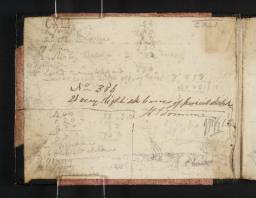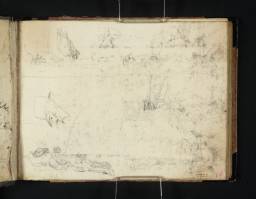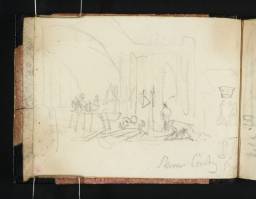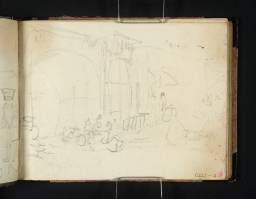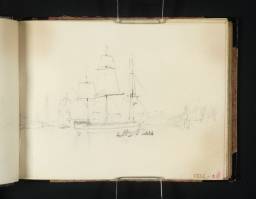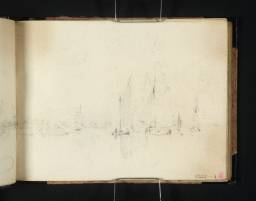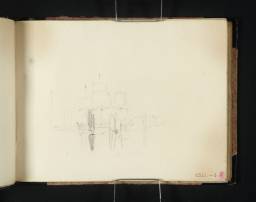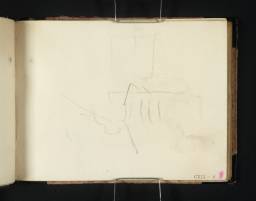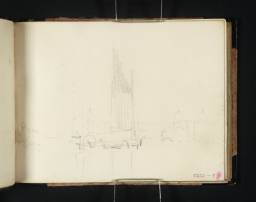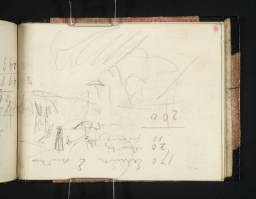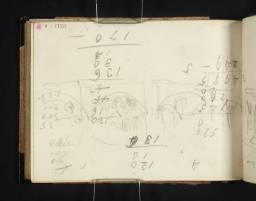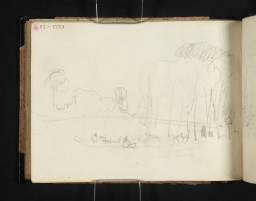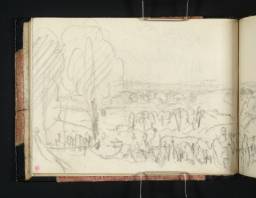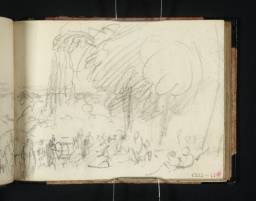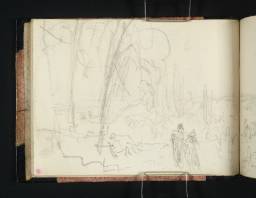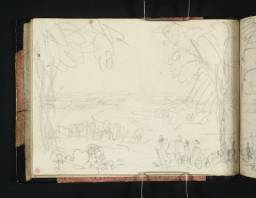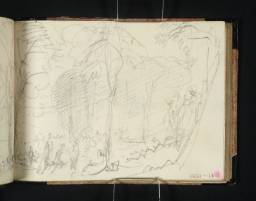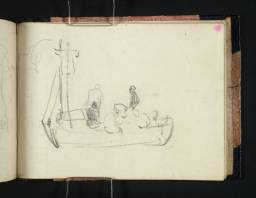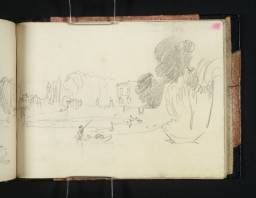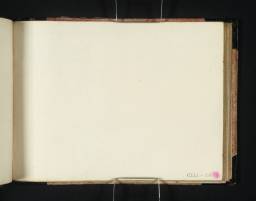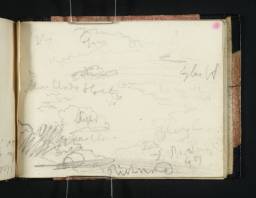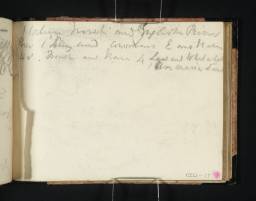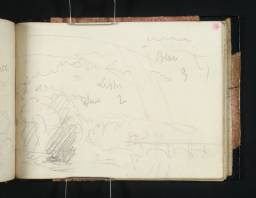Turner Bequest CXLI
Small pocket book, bound in boards, with black leather spine and corners
36 leaves of white wove paper
Approximate page size 88 x 114 mm
Watermarked ‘J WHATMAN | 1813’
Inscribed by Turner in ink ‘106 Hints River’ on a label on the spine (D40854)
Endorsed by the Executors of the Turner Bequest in ink ‘No 386 | 26 very slight leaves of pencil sketches’ and signed by Henry Scott Trimmer ‘H S Trimmer’ and by John Prescott Knight in pencil ‘JPK’ inside front cover. Finberg records a further endorsement by John Ruskin, ‘Inv.386. Some tiny marines and things good for distribution’
Inscribed by an unknown hand in pencil ‘CXLI’, stamped in black ‘CXLI’ and blind-stamped with the Turner Bequest monogram inside front cover
36 leaves of white wove paper
Approximate page size 88 x 114 mm
Watermarked ‘J WHATMAN | 1813’
Inscribed by Turner in ink ‘106 Hints River’ on a label on the spine (D40854)
Endorsed by the Executors of the Turner Bequest in ink ‘No 386 | 26 very slight leaves of pencil sketches’ and signed by Henry Scott Trimmer ‘H S Trimmer’ and by John Prescott Knight in pencil ‘JPK’ inside front cover. Finberg records a further endorsement by John Ruskin, ‘Inv.386. Some tiny marines and things good for distribution’
Inscribed by an unknown hand in pencil ‘CXLI’, stamped in black ‘CXLI’ and blind-stamped with the Turner Bequest monogram inside front cover
Accepted by the nation as part of the Turner Bequest 1856
Exhibition history
References
This small pocket book contains mainly views of the River Thames and Richmond. Finberg gave its date as 1815–18 but the range should perhaps be extended to circa 1820.
Gerald Wilkinson finds Turner’s name for the book ‘accurate enough’. It implies a role for these mostly slight sketches in forming compositions for pictures, and several can be traced back to them. Folios 32 verso–33 (D10640–D10641) seem to have an early idea for The Decline of the Carthaginian Empire (Tate N00499)1 exhibited at the Royal Academy in 1817. As in earlier sketchbooks, Thames scenery has morphed in Turner’s imagination into an ancient seaport. In particular he used the book for ideas for a contemporary subject, England: Richmond Hill, on the Prince Regent’s Birthday (Tate N00502)2 exhibited at the Royal Academy in 1819. Three double-spread composition sketches, with numerous figures, are on folios 10 verso–13 (D10601–D10606). Across folios 26 verso–27 (D10629–D10630) Turner drew a part-copy, with colour notes, after Antoine Watteau’s Enchanted Isle (private collection) which belonged to his friend the watercolourist James Holworthy and had formerly been in the collection of Sir Joshua Reynolds, whose country house overlooked much the same view as Turner painted in England: Richmond Hill. Watteau’s subject of elegant figures in a garden gave Turner a prototype for his picture. Also of interest, and newly recognised, are sketches of the Skinners Company barge and a costume study of the Barge Master, folios 1 verso–2 (D10588–D10589), perhaps drawn below Waterloo Bridge (opened in 1817) or Richmond Bridge during the Company’s annual summer outing to Richmond. Turner may have noted these details because he planned to show barges in the background of his picture, albeit in the distance.
The drawings here throw no real light on the actual event depicted in England: Richmond Hill nor whether it was drawn on the spot or imagined. Turner cannot have witnessed the party given for the Prince Regent by Lady Cardigan at her house in Richmond on 12 August 1817, which Jean Golt has identified as the subject,3 as he had left London for the Netherlands two days earlier. Charles Stuckey had previously pointed to a visit by the Regent to Richmond Hill from Kew Palace on 10 August 1818, two days before his actual birthday,4 and the warm sunshine in Turner’s picture belongs to August rather than April; Stuckey also noted that the Regent was in London when his official birthday was celebrated on 23 April that year. Turner perhaps read of these events, heard them described or combined elements of both. If made on the spot his drawings cannot show Lady Cardigan’s garden as it was at the bottom of the hill by the river, not at the top as in the picture. From his house at Twickenham, Sandycome Lodge, Turner had easy access to Richmond and must have seen various summer fêtes there, such as the Skinners’ party mentioned above which culminated in a reception at the Star and Garter Hotel. Turner made the famous view from the hill the subject of a number of drawings and watercolours; those here overlap with more in the Richmond Hill; Hastings to Margate sketchbook (Tate D10409–D10585; D40868; D41539; Turner Bequest CXL).
Turner’s visit to the Continent in 1817 seems to have interrupted rather than ended his use of the sketchbook. There is no internal evidence that he took it with him, although sketches of fairly generic marine compositions could have served for pictures inspired by the trip. Commentators from Finberg to Butlin and Joll have noted a connection between folio 3 verso (D10591) and Entrance of the Meuse: Orange-Merchant on the Bar, Going to Pieces... (Tate N00501)5 exhibited at the Royal Academy in 1819. One or two dead calms might relate in general terms to Dort, or Dordrecht, the Dort Packet-Boat from Rotterdam Becalmed (Yale Center for British Art, New Haven, Connecticut)6 shown the previous year and one of a number of works listed on folio 35 verso (D10646). However, the sketches are probably on the Thames below the Pool of London, or at Greenwich as on folio 7 (D10595).
Perhaps the most tantalising subjects in the book are two variant compositions related to Rome from the Vatican. Raffaelle, Accompanied by La Fornarina, Preparing his Pictures for the Decoration of the Loggia (Tate N00503)7, exhibited at the Academy in 1820, which David Hill was the first to recognise but have attracted scant notice since. It is difficult to see why Turner would need to make these very small drawings after his return from Italy, when he had made larger and more detailed ones in Rome. Yet it also seems rather unlikely that he would be able to imagine these compositions, especially with the anachronistic inclusion of Bernini’s arcades, before seeing the actual site. However, there is nothing to suggest that he took this book to Italy.
The works listed on D10646 were said by Finberg to be ‘drawings in hand 1817 or beginning 1818.’ In fact they also include paintings: Raby Castle, the Seat of the Earl of Darlington (Walters Art Gallery, Baltimore, Maryland);8 the aforementioned Dort; The Field of Waterloo (Tate N00500)9 exhibited in 1818; and either the original or a version of View of the Temple of Jupiter Panellenius, in the Island of Aegina, with the Greek National Dance of the Romaika: the Acropolis of Athens in the Distance. Painted from a Sketch Taken by H. Gally Knight, Esq. in 1810 (collection of the Duke of Northumberland)10 exhibited in 1816. Perhaps one of the latest works listed is the watercolour Cologne (private collection, Japan)11 commissioned and bought by James Rivington Wheeler some time between 1818 and 1820. Other clients named include the Earl of Strathmore, James Hakewill, Thomas Allason and the publishers Longman and the Cookes.
Technical notes
How to cite
David Blayney Brown, ‘Hints River sketchbook c.1815–20’, sketchbook, April 2012, in David Blayney Brown (ed.), J.M.W. Turner: Sketchbooks, Drawings and Watercolours, Tate Research Publication, December 2012, https://www

